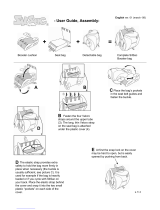
Introduction
8
Volvo Cars and the environment
Efficient emission control
Your Volvo is manufactured following the
concept Clean inside and out – a concept
that encompasses a clean interior environ-
ment as well as highly efficient emission con-
trol. In many cases the exhaust emissions are
well below the applicable standards.
In addition there is a special radiator coating,
PremAir®
1
, which can convert hazardous
ground-level ozone into pure oxygen when
the ozone passes the radiator. The higher the
ozone content in the air the more ozone is
converted.
Clean air in the passenger
compartment
A passenger compartment filter prevents
dust and pollen from entering the passenger
compartment via the air intake.
A sophisticated air quality system, IAQS
2
(In-
terior Air Quality System) ensures that the in-
coming air is cleaner than the air in the traffic
outside.
The system consists of an electronic sensor
and a carbon filter. The incoming air is moni-
tored continuously and if there is an increase
in the level of certain unhealthy gases such
as carbon monoxide then the air intake is
closed. Such a situation may arise in heavy
traffic, queues and tunnels for example.
The entry of nitrous oxides, ground-level
ozone and hydrocarbons is prevented by the
carbon filter.
Textile standard
The interior of a Volvo is designed to be
pleasant and comfortable, even for people
with contact allergies and for asthma suffer-
ers. All of our upholstery and interior textiles
are tested with respect to certain unhealthy
substances and allergens as well as emis-
sions. This means that all textiles fulfil the re-
quirements in the Öko-Tex 100
3
standard, a
major advance towards a healthier passen-
ger compartment environment.
Öko-Tex certification covers seatbelts, car-
pets, thread and fabrics for example. The
leather in the upholstery undergoes chromi-
um-free tanning with natural plant substanc-
es and fulfils the certification requirements.
Volvo workshops and the environment
Regular maintenance creates the conditions
for long service life for the car and low fuel
consumption, and this way you contribute to
a cleaner environment. When Volvo’s work-
shops are entrusted with the repair and
maintenance of the car, it becomes part of
our system. We make clear demands regard-
ing the way in which our workshops are de-
signed in order to prevent spills and dis-
charges into the environment. Our workshop
staff have the knowledge and the tools re-
quired to guarantee good environmental
care.
1
Option for 5-cylinder engines.
PremAir
® is a registered trademark of
Engelhard Corporation.
2
Option
3
More information on www.oekotex.com






















